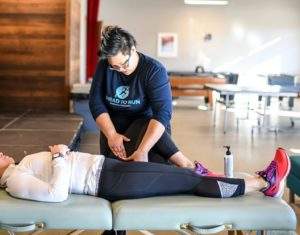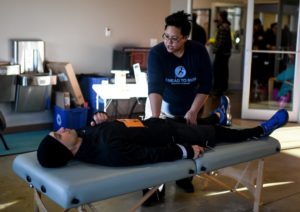How to Prepare Your Winter Body for Spring Running!
Every season presents its own challenges for runners. While many Seacoasters run year round, running in the winter months can be especially tough. Uneven snow packed roads and trails, and icy streets and sidewalks often result in muscle aches, pains and sometimes injuries. Even using microspikes for added traction can throw off your gait by a small fraction that can lead to muscle imbalance and eventually pain if not dealt with.
Sara Kotila, owner and founder of Knead to Run Massage Therapy in Exeter and Portsmouth, NH shares her advice.

Stretch These 4 Muscle Groups to Prepare for Spring Running!
Psoas
The psoas (pronounced so-as) is a very important muscle that stabilizes the pelvis. It’s often mistakenly referred to as the hip flexor since its secondary function is to flex or bend the leg at the hip. Since the psoas is a deep abdominal muscle, runners who have weak core strength often experience back pain or pain deep in the hip.
Tip: Stretching might feel good temporarily, but the best way to help your psoas is to do reverse crunches or hip flexes with a band tied around your foot.
Adductors
Your adductors, the muscles of your inner thighs, are made up of five key muscles. They, along with the psoas, help to stabilize the pelvis. If your pelvis is not stable, the adductors tighten up and can cause an imbalance with the glutes.
Tip: Foam rolling is a simple way to relieve the tension in this muscle group. To foam roll the adductors, turn your roller so that it’s horizontal, and place it just above the inside of the knee. Moving in slow increments (about 1-inch per minute), work from the knee to the pelvic bone as high as you can for about 90 seconds.
Tensor Fascia Lata (TFL)
This small, but mighty muscle sits in the front of your hip just above your pants pocket. When runners say their hip flexors are tight or painful, they are often talking about the TFL. Loosening these muscles might help if your IT band is a little cranky. The main reason why runners experience pain in their hip flexors is not that they are tight; it’s often because they are weak from too much sitting.
Tip: Use a small ball or a foam roller with ergonomic curves such as the TPiN Vector will get into this space better than your standard foam roller.
Find Out If You Have Weak Hip Flexors
Here’s a simple test:
- Kneel on the floor with one leg at a 90-degree angle, foot planted firmly on the floor.
- Make sure your pelvis is in a neutral position.
- Lean forward slightly like you’re stretching your quad (you may want a partner to watch you, since many people tend to hyper-extend their pelvis). If you feel tightness in your quad, you likely have tightness or weakness in your hip flexors.
Glutes & Lateral Hip Rotators
If your back hurts, it’s your bum’s fault. No, really! Here’s a podcast episode of the same name. Pain in the glutes can cause pain in the low back, the hips, and even the quads. Weak and underactive glutes can also sometimes be the cause of dysfunction in the hamstrings.
The lateral hip rotators can cause a literal pain in the butt, and/or sciatic-like pain, that travels down the leg and makes running uncomfortable.
Tip: Sometimes rolling these muscles out with a foam roller or ball can help. Targeting the attachment points at the sacrum and the outside of the femur, before rolling the muscle itself, can often yield the best results. Just be careful not to use too much pressure.

Foam rolling, stretching and strength training can and should be something you do regularly to keep your body in peak running condition. If your roller isn’t quite doing the trick, or stretching doesn’t seem to be giving you long term relief, seeing a massage therapist could be the thing you need to help you toward your next personal record.
You can schedule an appointment online or by calling Sara’s office at (603) 370-9193.